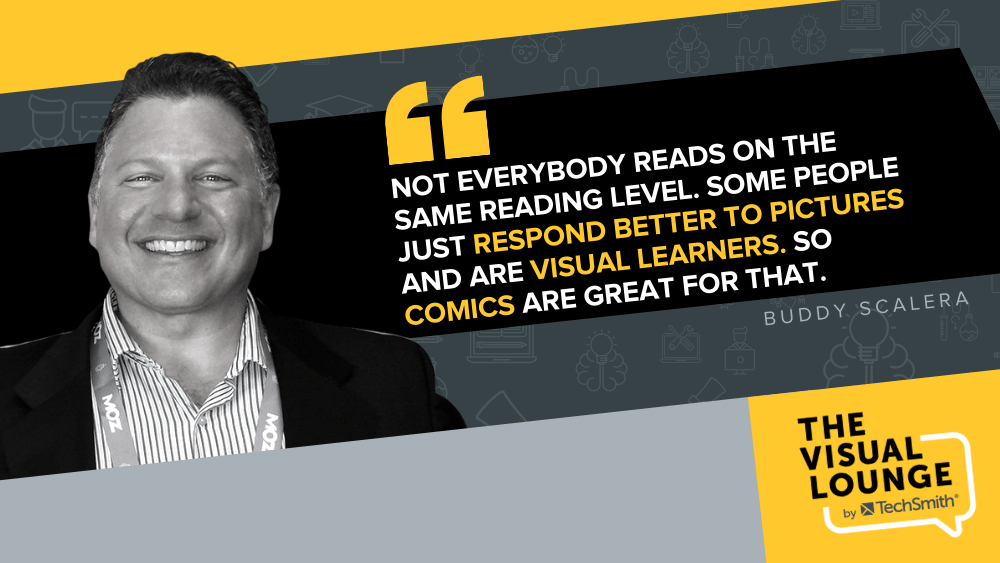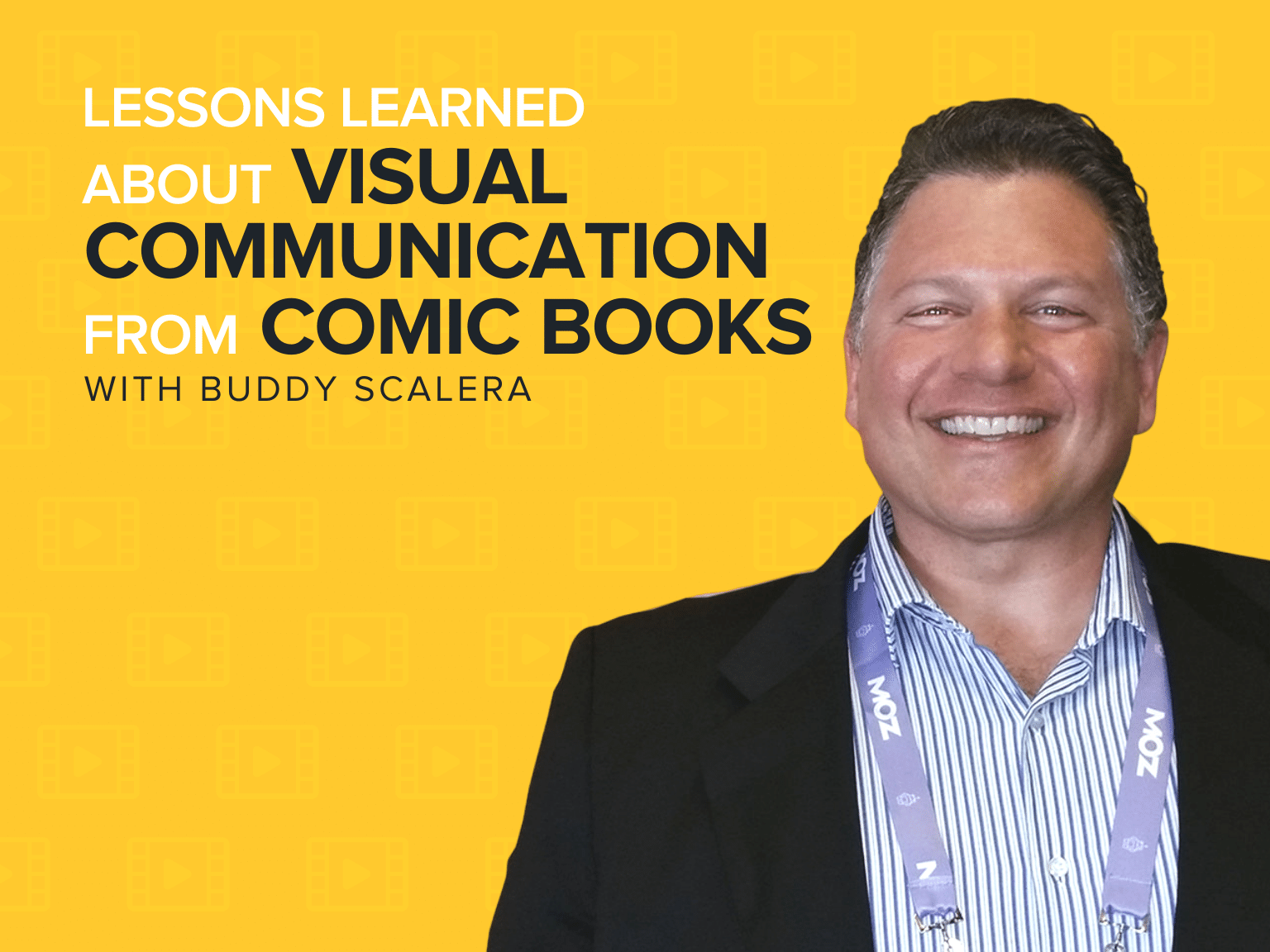What can we learn from comic books that we can apply to instructional design or marketing?
It may seem like an odd question, but it turns out we can learn a whole lot from comic books.
Buddy Scalera, comic book writer, educator, and Founder of Comic Book School, joins The Visual Lounge to share those lessons with us. Whether you’re creating your own comic book or designing instructional videos for a corporate environment, we can all take something from comic books.
In this episode, Buddy explains why comics can help contextualize your brand in a simpler and less expensive way than other mediums. He shares some of his biggest lessons about visual communication and some details about his fantastic career so far.
Buddy is an award-winning creator with a focus on marketing, storytelling, and technology. For the past 25 years, he’s moonlighted as a comic book writer. Buddy has had the chance to work on Marvel favorites like Deadpool as well as many other comics. He’s won three awards, including the Content Marketing Institute Award.
This interview is full of advice on achieving great visual design, storytelling, and getting your message across in a fun, clear, and interesting way.
Blending the worlds of marketing and comic books
It may appear a strange combination, but it seems to fit in better than you might expect. Buddy is a marketer by trade with a background in journalism and tech. While he was working in the comic book industry, building websites for comic book pros, it all just evolved from there. Soon enough, he found himself writing comics.
One day it hit him. He realized that visual storytelling on comic books wasn’t all that different from the stuff he was doing as a marketer or website designer. So, he combined the two. By day, he works in marketing and software, but he still keeps a foot in comic books.
“Every single day, we are all telling visual stories, whether we’re making videos, or websites, or slide decks. We have to learn how to think visually, and comics are just great practice for that.”
Working with restrictions in different mediums
Working with any kind of media, you’re bound to face some kind of restrictions. With comic books, you’re constrained by the space on the page and what you can squeeze on there.
In the world of video, you’re limited by time and budget. The way Buddy likes to differentiate video and comic is through time and space. With video, you’re restricted by time. With comics, you’re restricted by space.
But Buddy’s advice for creating content for any other medium is to know it well and create content specifically for it.
“I think that it’s really important that when you think about what you want to do, or what story you want to tell, be it a PowerPoint or a video, you’re creating for the medium.”
Where comics meet marketing

Where does the true intersection between comics and marketing fall? Buddy believes that comic books can teach us so much about visual storytelling and getting a message across.
People are visual learners for the most part, and not everyone reads at the same reading level, so using visuals over written directions is often best. Comics are great for this and are ideal for rapid communication.
“Some people just respond better to pictures and are visual learners. So comics are great for that.”
How to get your message across clearly
The reason comics are such an interesting way to explore communication is because they force you to be more visually interesting.
As Buddy explains, a comic about Peter Parker getting medication for Aunt May could easily be an image of him sitting in a chair mulling things over. Or it can be him swinging across the city, demonstrating his powers instead. The second version says so much more about the character and the world.
Another great thing about comics is that you can access any environment that you want. You don’t have to rely on budget constraints to paint a picture. You can explain everything on the page in a visually interesting, clear, and engaging way.
“I think one of the things that we can take away from that marketing is that you need to be visually interesting, but you need to tell a succinct, clear story in a short amount of time. People’s attention span for your marketing is very limited.”
Back to the marketing world, the same lessons apply. If you want to sell a car, you could show a static image of a car in a showroom but it’d be pretty boring.
Or you could show a video that shows what the car can do.
“You can show it in an environment. If it’s a four-wheel, you can show it driving off-road, leaping over a cliff or a mountain. These are the kinds of things that we can do as visual storytellers to grab the audience.”
How to make a corporate comic…the right way

If you’ve come across a few corporate comics in your life, you’ve probably seen them done well…and not so well. But luckily, Buddy has some tips on how to make it work.
The main tip that Buddy has is to go to someone who understands the medium. Not amateurs. Not first-timers. People can tell when a movie or a comic is created with poor storytelling, so it’s important to prioritize that quality and make sure it’s done well. It may cost you more, but if it’s worth doing, it’s worth doing well.
“Make sure that you’re hiring the right people, you’re coming in with the right budget, and then just commit to the medium and just say, we’re not going to make a comic that talks at people, we’re going to make a comic that is engaging and entertaining.”
Buddy’s favorite thing about using comics to improve visual marketing
Buddy believes that overall, comics do a great job of helping you contextualize your brand in a way that would be way more expensive in other mediums. Comics can tell a story, they can get a message across, and Buddy believes they should be used more by brands.
He brings up the average Ikea instructions. Rather than being the nightmare that they are, they could easily be turned into a simple comic.
“Let’s face it. This is an inexpensive medium compared to other production mediums. And it’s much faster. So I think what we need to do is really think about what is the power of that medium? It’s the ability to open a comic, leave it there and fix an engine or assemble furniture, that can be an effective way that helps a brand.”
For more insights and tips on visual design and the lessons comics can teach us, it’s definitely worth watching or listening to the full episode. You can also head over to TechSmith Academy for more tutorials and advice on leveling up your content.



Share